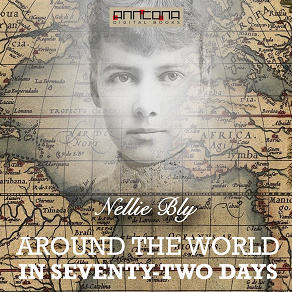
Förlag: Anncona Media
Kategori:
Memoarer & Biografier Resor & geografi Engelskspråkiga
Tillgänglig sedan: december 2015
Uppläsare: Mary Reagan
Length: 5 timmar 60 minuter
Around the World in Seventy-Two Days
Around the World in Seventy-Two Days is a book by journalist Elizabeth Jane Cochrane, writing under her pseudonym, Nellie Bly. The chronicle details her 72-day trip around the world, which was inspired by the book, Around the World in Eighty Days by Jules Verne. She carried out the journey for the newspaper New York World.
In 1888 Bly suggested to her editor at the New York World that she take a trip around the world, attempting to turn the fictional Around the World in Eighty Days into fact for the first time. A year later, at 9:40 a.m. on November 14, 1889, she boarded the Augusta Victoria, a steamer, and began her 24,899-mile journey.
She took with her the dress she was wearing, a sturdy overcoat, several changes of underwear, and a small travel bag carrying her toiletry essentials. She carried most of her money (£200 in English bank notes and gold, as well as some American currency) in a bag tied around her neck.
At the same time The New York newspaper Cosmopolitan sponsored its own reporter, Elizabeth Bisland, to beat the time of both Phileas Fogg and Bly. Bisland would travel the opposite way around the world.
During her travels around the world, Bly went through England, France (where she met Jules Verne in Amiens), Brindisi, the Suez Canal, Colombo (Ceylon), the Straits Settlements of Penang and Singapore, Hong Kong, and Japan. The development of efficient submarine cable networks and the electric telegraph allowed Bly to send short progress reports, although longer dispatches had to travel by regular post and thus were often delayed by several weeks.
Bly travelled using steamships and the existing railroad systems, which caused occasional setbacks, particularly on the Asian leg of her race. During these stops, she visited a leper colony in China and, in Singapore, she bought a monkey.
Just over seventy-two days after her departure, Bly was back in New York. She had circumnavigated the globe, traveling alone for almost the entire journey. Bisland was, at the time, still crossing the Atlantic, only to arrive in New York four and a half days later. She also had missed a connection and had had to board a slow, old ship (the Bothnia.) Bly's journey was a world record, although it was bettered a few months later by George Francis Train, who completed the journey in 67 days.
Nellie Bly (1864-1922) was the pen name of American journalist Elizabeth Jane Cochrane. She remains notable for two feats: a record-breaking trip around the world in emulation of Jules Verne's character Phileas Fogg (Around the World in Seventy-Two Days, published in 1890), and an exposé in which she faked insanity to study a mental institution from within (Ten Days in a Mad-house, 1887).
Provlyssna
Information
Stöds av följande plattformar
PC/Mac
Smartphone
